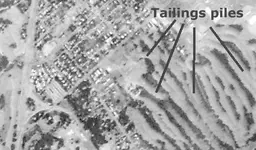UncleVinnys
Bronze Member
- Joined
- Dec 27, 2007
- Messages
- 1,150
- Reaction score
- 171
- Golden Thread
- 0
- Location
- Hancock Street, Folsom, CA
- Detector(s) used
- Minelab Equinox 600
They say that dredging from the 1800s captured only about half the gold from a river.
The other half is still in the tailings piles, those mounds of river rock left over from
the dredging operation.
I'm in the Folsom, California area, and there are acres of these tailings piles,
some on public land, some private, but mostly designated historic sites, so
they are off limits. But some private lots still have tailings piles on them,
and there is one where the owner gave me permission to scan.
I wonder, though, how to go about it.
These are rock piles between 8 and 20 feet high, with river rock
ranging from 2 inches to more than 12 inches across.
I figure I will start at the bottom, see if there are any drainage
or run-off basins I can scan.
But I wonder - aside from moving tons of rock by hand,
is there a way to scan the pile for gold content??
Any suggestions??
The other half is still in the tailings piles, those mounds of river rock left over from
the dredging operation.
I'm in the Folsom, California area, and there are acres of these tailings piles,
some on public land, some private, but mostly designated historic sites, so
they are off limits. But some private lots still have tailings piles on them,
and there is one where the owner gave me permission to scan.
I wonder, though, how to go about it.
These are rock piles between 8 and 20 feet high, with river rock
ranging from 2 inches to more than 12 inches across.
I figure I will start at the bottom, see if there are any drainage
or run-off basins I can scan.
But I wonder - aside from moving tons of rock by hand,
is there a way to scan the pile for gold content??
Any suggestions??
Attachments
Upvote
0






